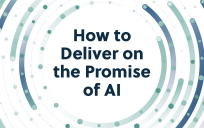 Backlogs are the bane of government. Delays of weeks, months or even years are too often incurred in executing a number of everyday tasks, including adjudicating claims, scheduling appointments, hiring new employees, procuring services, conducting investigations and approving applications.
Backlogs are the bane of government. Delays of weeks, months or even years are too often incurred in executing a number of everyday tasks, including adjudicating claims, scheduling appointments, hiring new employees, procuring services, conducting investigations and approving applications.
Few agencies are exempt from these challenges, and the resulting costs are both financial and reputational, as their inability to deliver core services in a timely manner directly impacts their ability to execute the mission. However, for those people whom agencies serve, the stakes are even higher, as delays can have livelihood, peace of mind, or even life and death consequences.
Broadly speaking, these backlogs happen for two reasons: an over-reliance on ad hoc, manual processes that create operational inefficiencies and/or a need for subjective, often specialized assessment or adjudication that exceeds capacity. Underlying issues can include poor access to decision-making evidence and information, and fluctuating demand with frequent or unpredictable spikes.
Artificial Intelligence Can Help
Artificial Intelligence (AI) solutions are ideally suited for these types of situations. They can automate low-value, repetitive tasks, executing them more efficiently and accurately than humans, freeing individuals to play higher-level roles requiring greater empathy, cognitive analysis and more strategic thinking. AI can also improve the speed and quality of decision making, allowing for better navigation of increasingly complex and massive amounts of data; allowing us to more consistently arrive at the best possible outcome.
In commercial markets, AI is being used to streamline and optimize operations and provide more personalized customer service. Think of an insurance company that approves a claim with just a photo from your smartphone. Within the federal government, it has been used widely in the national security and cybersecurity realms to detect patterns of anomalous behavior, predict where bad actors might strike, and take anticipatory measures to thwart the attack. Using these same methods, AI is also now being used to detect fraud, improve health outcomes, predict crop yields and approve claims.
Use the Cloud
Enabled by the scale cloud computing offers and the increasing availability of data, AI is a combination of technologies that allow smart machines to extend human capabilities. It uses massive processing power, intelligent algorithms, and huge data sets to mimic human cognitive abilities such as sensing the immediate environment, comprehending what’s happening, acting on this information and learning through experience. Autonomous vehicles are the best example of AI using these human-like abilities to accomplish a complicated task that requires constant assessment and recalibration in real time.
One way to think about the range of available AI solutions is to evaluate them in terms of both automating and augmenting. Automating involves taking over underlying tasks routinely done by humans, such as simple data entry, to allow them to focus on higher value work; augmenting bolsters workers skills, knowledge, and experience, helping them become smarter and more productive or effective.
Looking first at what processes and tasks can be automated or augmented can help agencies understand how AI can advance mission requirements. For this evaluation, AI solutions can be considered based on two criteria: first, the predictability and repeatability of the task and, second, the complexity of the input.
Is Your Data Ready?
In terms of data, in some cases it is structured and well-known. At the other end of that spectrum, data can be semi- or unstructured —speech, social media, multimedia data or sensor data. Agencies can use the work complexity/data complexity framework to map tasks to four primary types of activity models: efficiency, expert, effectiveness and innovation. By using the matrix, agencies can see which tasks cluster around either automation or augmentation and then can begin to map the appropriate types of AI solutions for exploration and testing.
Getting Started
More so than any preceding technologies, AI creates living systems that will continue to advance, evolve and mature over time. This is inherent in the self-learning and improving nature of many AI technologies. Successful adoption requires both clear guidelines and guardrails for use as well as a commitment to cultivating the technology so it can be adapted and trained for specific use cases.
This means that enterprises including federal agencies need to clearly define upfront how AI should and should not be used. They should also embrace user-driven design and iterative agile development to best leverage available data and configure technologies for required roles. And recognizing its pervasive and transformative effect, they must also plan to make it a core competency for their organization—both within IT as well as the mission, business and operational groups that AI will support.
Given the breadth of use cases that AI can address, it can be a bit overwhelming to think about where to begin. With AI, agencies can now start to think big, and not shy away from tackling the biggest obstacles to mission success that have been seemingly unsolvable in the past.
By starting with a well-defined area of opportunity, iterating, testing, and piloting AI solutions mapped to specific processes and tasks, agencies will begin to see rapid changes in service delivery capabilities and staff productivity. By combining humans and AI, agencies can achieve breakthroughs in mission capabilities that were unthinkable in the past.
Dominic Delmolino is a GovLoop Featured Contributor. He is the Chief Technology Officer at Accenture Federal Services and leads the development of Accenture federal’s technology strategy. He has been instrumental in establishing Accenture’s federal activities in the open source space and has played a key role in the business by fostering and facilitating federal communities of practice for cloud, DevOps, artificial intelligence and blockchain.





Thanks for sharing Dominic! A proper use of AI can definitely transform the way government functions.